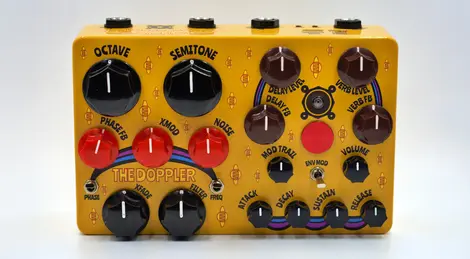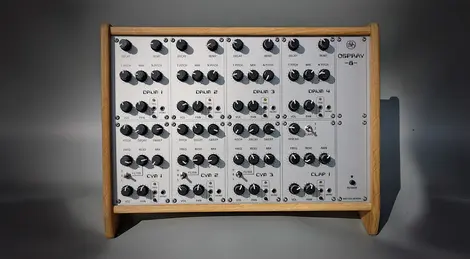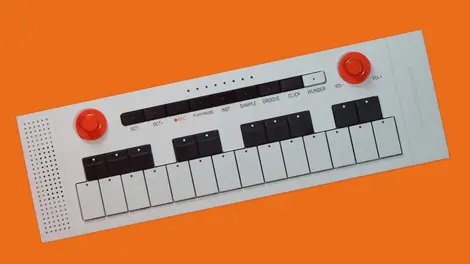The Mutable Instruments Ambika: A Modular Approach to Polyphonic Synthesis

When Mutable Instruments released the Ambika in 2012, it represented an ambitious evolution of their successful Shruthi monosynth. Rather than simply adding more voices to create a traditional polysynth, Olivier Gillet designed something far more flexible: a true multi-voice hybrid instrument that could function as a 6-voice polysynth, six independent monosynths, or anything in between.
Building on the Shruthi Foundation
The Ambika emerged during Mutable Instruments' DIY period, before the company shifted its focus entirely to Eurorack modules. Each Ambika consisted of a motherboard housing the control interface and six separate voicecards – essentially six boosted versions of the Shruthi synthesizer, each with digital waveform synthesis followed by analog filtering and amplification.
This modular architecture meant that each voice could use a different filter board, creating a polysynth where individual notes could have distinctly different tonal characteristics. The open-source design, released under a Creative Commons license, allowed builders worldwide to construct their own units and experiment with different configurations.
Voicecard Variations
Like the Shruthi before it, the Ambika supported multiple analog filter options through interchangeable voicecards. Mutable Instruments offered three official designs: the SMR (a four-pole filter inspired by classic Roland designs), the 4P (featuring advanced pole-mixing techniques from the Oberheim Xpander), and the SVF (a versatile multimode filter).
The beauty of this system was its flexibility. A builder could install six identical voicecards for consistent polyphonic performance, or mix different filter types to create a unique sonic palette. Each voicecard also featured individual audio outputs, allowing voices to be processed separately through external effects or mixed independently.
Synthesis Architecture
Each of the Ambika's six voices packed considerable synthesis power. Two digital oscillators per voice provided access to 36 different waveform algorithms, ranging from classic analog shapes to sophisticated wavetables supporting continuous morphing. A sub-oscillator could be configured either as a traditional bass boost or as a transient generator for percussive attacks.
The modulation capabilities were extensive: three ADSR envelopes and four LFOs (three patch-level plus one per voice), all routable through a 14-slot modulation matrix with four modulation modifiers. Pre-filter overdrive and bit-crushing effects added character, while built-in arpeggiators and step sequencers expanded creative possibilities.
Flexible Voice Allocation
What truly set the Ambika apart was its voice mapping system. Rather than forcing users into traditional polyphonic operation, the instrument could be configured in numerous ways:
- A single 6-voice polyphonic patch for traditional polysynth performance
- Six completely independent monophonic parts, each with its own patch and MIDI channel
- Two 3-voice polyphonic patches for split keyboard setups
- Any combination of mono and poly configurations
This flexibility made the Ambika equally suitable for playing rich pad sounds, creating complex multitimbral arrangements, or triggering six completely different synthesized voices from a sequencer.
The Building Experience
As a DIY kit, the Ambika challenged builders more than the Shruthi had. The project involved assembling not just one circuit board but seven (the motherboard plus six voicecards), requiring solid soldering skills and careful attention to detail. However, the comprehensive documentation and supportive community helped many builders successfully complete their instruments.
The price point of around $160 made the Ambika remarkably affordable for a 6-voice polysynth, though this only covered the circuit boards and components – builders needed to source their own case and panel. This led to a wide variety of custom enclosures, from simple desktop boxes to elaborate rack-mounted designs.
Modern Revivals
Though Mutable Instruments discontinued the Ambika in 2015 and has since distanced itself from supporting the project, the open-source design continues to inspire modern interpretations. Michigan Synth Works' Xena represents a contemporary evolution, offering a fully machine-assembled version with an updated layout, improved power supply, and the addition of AS3109 filter voicecards featuring modern reissues of the original Roland filter chip.
Finding an original DIY-built Ambika has become challenging and costly, making these modern revivals an attractive option for those wanting to experience the Ambika's unique approach to polyphonic synthesis without the soldering iron.
Storage and Control
The Ambika featured SD card storage for unlimited patches and programs, with full undo/redo functionality through version management. The control interface used a 2x40 character LCD display with a clickable encoder for navigation, supplemented by eight potentiometers arranged in two rows. Eight LEDs indicated which synthesis page was active, while switches provided direct access to different parameter pages and part selection.
The extensive MIDI implementation made the Ambika responsive to external control, whether from keyboard controllers, sequencers, or DAW automation.
A Unique Voice in Synthesis
The Ambika represented something rare in the synthesizer world: a truly modular approach to polyphonic synthesis. By allowing different filter boards per voice, flexible voice allocation, and comprehensive modulation routing, it offered sonic possibilities that went far beyond traditional polysynths.
While Mutable Instruments moved on to focus on their celebrated Eurorack modules, the Ambika remains a fascinating example of the company's innovative design philosophy during their DIY period. For those who built or acquired one, it provided not just a powerful instrument but a platform for sonic experimentation that could adapt to countless musical situations.
The Ambika's influence continues through projects like the Xena and through the countless builders who learned advanced electronics and synthesis concepts through constructing this ambitious instrument. It stands as a testament to what's possible when open-source design meets creative synthesis architecture, offering flexibility and sonic diversity that remains compelling more than a decade after its release.







